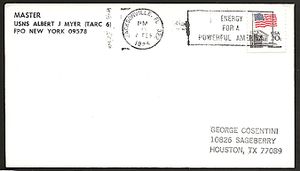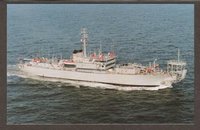ALBERT J MYER T-ARC 6
Ship Name and Designation History
This section lists the names and designations that the ship had during its lifetime. The list is in chronological order.
- USACS ALBERT J. MYER (U.S. Army) Transferred to U.S. Army and Commissioned February 7 1952
- USNS ALBERT J. MYER T-ARC-6 Placed In Service 8 November 1973 - Out of Service 13 February 1994
Neptune Class Cable Laying and Repair Ship
Keel Laid April 14 1945 as Maritime Commission Hull No. 2668
Launched 7 November 1945
Delivered to Maritime Commission for lay up in the National Defense Reserve Fleet
Returned to Maritime Commission June 13 1966
Transferred to Military Sea Transportation Service (MSTS)
Classified Cable Laying/Repair Ship (ARC) (Date unknown)
Struck from the Navy Register 19 August 1994
Transferred to the Maritime Administration (MARAD) for lay up in the National Defense Reserve Fleet April 1 1998
Returned to Navy custody August 24 2005 for scrapping
Dismantled in Brownsville, TX in 2005
Naval Covers
This section lists active links to the pages displaying covers associated with the ship. There should be a separate set of pages for each incarnation of the ship (ie, for each entry in the "Ship Name and Designation History" section). Covers should be presented in chronological order (or as best as can be determined).
Since a ship may have many covers, they may be split among many pages so it doesn't take forever for the pages to load. Each page link should be accompanied by a date range for covers on that page.
- Covers Page 1 (DATE RANGE)
Postmarks
This section lists examples of the postmarks used by the ship. There should be a separate set of postmarks for each incarnation of the ship (ie, for each entry in the "Ship Name and Designation History" section). Within each set, the postmarks should be listed in order of their classification type. If more than one postmark has the same classification, then they should be further sorted by date of earliest known usage.
A postmark should not be included unless accompanied by a close-up image and/or an
image of a cover showing that postmark. Date ranges MUST be based ONLY ON COVERS IN
THE MUSEUM and are expected to change as more covers are added.
>>> If you have a better example for any of the postmarks, please feel free to replace the
existing example.
|
Postmark Type |
Date From to Date To |
Thumbnail Link To Postmark Image |
Thumbnail Link To Cover Image |
|---|
|
USPS Slogan |
1985-02-04 |
 |
Note:
Other Information
Awards, Citations and Campaign Ribbons...
Navy Meritorious Unit Commendation
Navy Battle "E" Ribbon
National Defense Service Medal
NAMESAKE - Named in Honor of Brigadier General Albert James Myer (September 20 1829 - August 1880)
Myer received his bachelor's degree from Hobart College in 1847, graduated from Buffalo Medical College in 1851, and became an assistant surgeon in the Army on September 18 1854. Already an accomplished telegrapher, he became an enthusiastic proponent of visual signaling while serving in Texas. In the late 1850s, Myer lobbied vigorously for the adoption of his method of signaling and for the establishment of an organization within the Army responsible for communication. In 1860, Congress created a major's billet on the Army staff for a signal officer, and Myer was appointed to fill the new slot. Between the summer of 1860 and the spring of 1861, he employed his system successfully during General Canby's campaign against the Navajo Indians. In June of 1861, Maj. Myer received orders to Washington, D.C., to organize and command a signal corps. Through the first two years of the Civil War, Myer carried out both administrative and operational responsibilities while also proselytizing in Washington for the establishment of the Signal Corps as a permanent entity in the Army. Brevetted a lieutenant colonel on May 27 1862 for his service on the staff of the Army of the Potomac, he received a full colonelcy as a result of the formal establishment of the Signal Corps on March 3 1863. However, conflict between Myer and the assistant secretary of war under whose supervision military telegraphy fell, resulted in his removal as chief signal officer in November 1863 and his assignment to the Military Division of the West Mississippi in which he served the remainder of the remainder of the Civil War. Following the war, Myer received the brevet rank of Brigadier General; but he did not really come into his own until July of 1866 when Congress reorganized the Signal Corps and, with the permanent rank of Colonel, he again became Chief Signal Officer. Myer headed the Signal Corps from 21 August 1867 until his death at Buffalo, N.Y., on 24 August 1880. During that time, he played a dominant role in the resumption of a storm warning service that previously had been provided by the Smithsonian Institution and its subsequent incorporation in 1870 as the United States Weather Bureau under the direction of the Signal Corps. Myer became a permanent brigadier general on June 16 1880, a little over two months before his death. Fort Myer in Arlington, Va. is also named in his honor

If you have images or information to add to this page, then either contact the Curator or edit this page yourself and add it. See Editing Ship Pages for detailed information on editing this page.
Copyright 2025 Naval Cover Museum